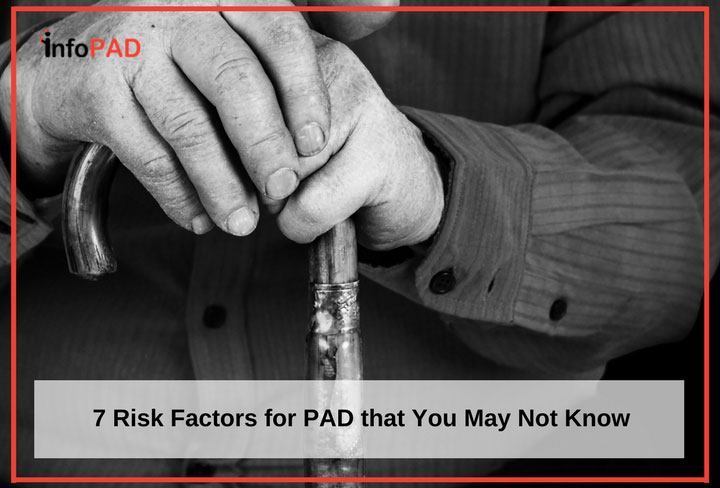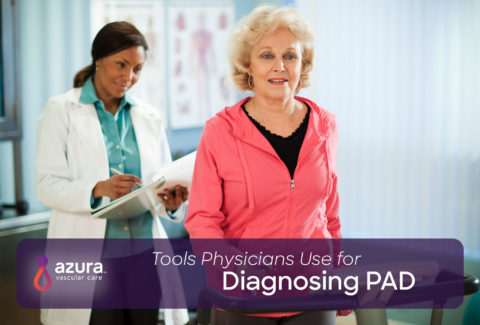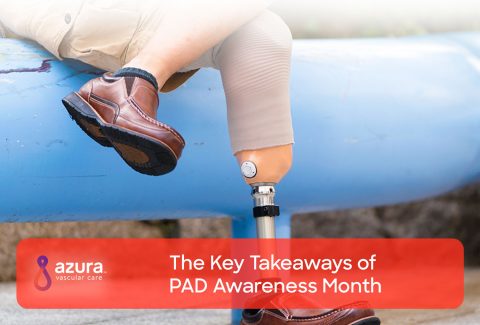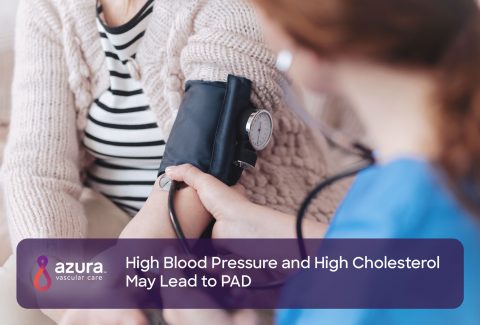
Peripheral artery disease (PAD), a type of peripheral vascular disease, is a condition that restricts blood flow to the limbs, especially the legs. It’s caused by the buildup of plaque in the arteries, usually in the legs, but it occasionally occurs in the arms, too.i PAD affects between 8 to 12 million Americans, mainly those over age 50.ii The disease results in poor circulation, increased risk of stroke, gangrene, the need for amputation and even, in the most extreme cases, death.
Being able to recognize peripheral artery disease risk factors is the first step in preventing the condition. At the very least, knowing these risk factors means you can be diagnosed and treated quickly, before more severe symptoms develop.
7 Common Risk Factors for PAD
1. Age Over 50
Being over 50 is one of the major risk factors for peripheral vascular disease.i As with many health conditions, growing older makes one more prone to this disease. You may want to consider PAD screening if you’re over 50, even if you have no apparent symptoms. Keep in mind that many times, patients don’t have any symptoms at all, or they assume the symptoms they are experiencing are simply due to the normal aging process. The tests for PAD are mostly non-invasive, so you have nothing to lose.
2. African Ethnicity
Those who are of African descent are about twice as likely to suffer from PAD as people of other races.i,iii If you’re an African-American over 50, it’s a good idea to undergo PAD screening.
The peripheral artery disease risk factors discussed above are uncontrollable. However, the following risks are ones that can often be mitigated with exercise, a healthy diet, good lifestyle choices and following the advice of your healthcare providers.
3. Hypertension
Hypertension, or high blood pressure, is a risk factor for many diseases of the cardiovascular system, including PAD.iii,iv While everyone has spikes in their blood pressure – during stress or exercise, for example – sustained blood pressures of greater than 120/80 can contribute to PAD. If you have high blood pressure, speak with your doctor about measures you can take to get it under control.
4. Smoking
Of course, it’s no secret that smoking is one of the worst things you can do in relation to your overall health. PAD risk is no exception.iii,iv The sooner you quit smoking, the sooner you begin to lower your chance of developing PAD, along with a host of other illnesses.
5. High Bad Cholesterol/Low Good Cholesterol
High levels of LDL, or the “bad cholesterol,” can lead to blocked arteries, which is the major cause of PAD. Also, insufficient levels of HDL, the good sort of cholesterol, can be equally damaging and also a risk factor for PAD. Finally, you should keep a close eye on another type of fat that is found in the blood – triglycerides having an elevated triglyceride number is yet another PAD risk factor.iii,iv
6. Type 2 Diabetes
Type 2 diabetes is a disease that can do a lot of damage to the circulatory system over time, so it should come as no surprise that it’s also a risk factor for PAD.iii,iv If you’re living with diabetes, keeping your blood sugar under control and following your healthcare providers’ advice will go a long way towards preventing PAD from developing or worsening in the future.
7. Family History
If someone in your family has suffered from vascular disease, your chances of developing PAD are greater. Knowing your family history can be powerful, in that you will be better able to watch for the early warning signs of the disease.
While there are multiple risk factors for PAD that may increase your chance of being diagnosed, knowing what they are and being mindful of how they apply to you is key. If you think you may have PAD, talk to your doctor right away. Early diagnosis is imperative to successful management and treatment of this disease. And keep in mind, while the diagnosis may be a shock at first, there are many minimally invasive PAD treatment options available that don’t require surgery.
Sources:
i American Heart Association. What is Peripheral Vascular Disease? https://www.heart.org/idc/groups/heart-public/@wcm/@hcm/documents/downloadable/ucm_300323.pdf (accessed 5/17/2017)
ii U.S. Department of Health and Human Services, National Institutes of Health, National Heart, Lung, and Blood Institute. Facts About Peripheral Arterial Disease (P.A.D.). https://www.nhlbi.nih.gov/health/educational/pad/docs/pad_extfctsht_general_508.pdf (accessed 5/17/2017)
iii Joosten, M.M., Pai, J.K., Bertoia, M.L., Rimm, E.B, Spiegelman, D., Mittleman, M.A., Mukamal, K.J. “Associations between conventional cardiovascular risk factors and risk of peripheral artery disease in men.” JAMA, 2012. 308(16): p. 1660-1667. https://www.ncbi.nlm.nih.gov/pmc/articles/PMC3733106/
iv Velescu, A., Clara, A., Penafiel, J., Grau, M., Degano, I.R., Marti, R., Ramos, R., Marrugat, J., Elosua, R. “Peripheral arterial disease incidence and associated risk factors in a Mediterranean population-based cohort. The REGICOR study.” Eur J Vasc Endovasc Surg, 2016. 51(5): p. 696-705. http://www.ejves.com/article/S1078-5884(15)00923-5/fulltext



